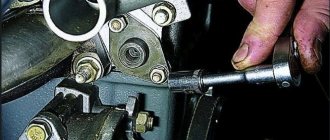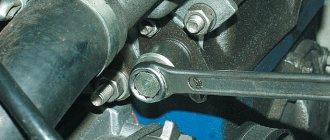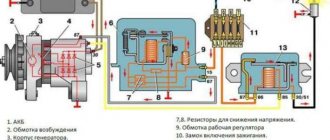Before tightening the chain on the VAZ 2106, make sure that the gas distribution mechanism is functioning properly.
If adjustment is not possible, replacing the old drive with a new one is a mandatory measure. Keep in mind that the chain will continue to stretch as it is used for longer. As its length changes, the gas distribution phases are disrupted. This is followed by a mismatch between the exhaust and intake strokes, which is why the operation of the engine as a whole is disrupted. If the quality of the chain is not high enough, it is likely to break and cause excessive wear. You may also be interested in an article devoted to how the VAZ-2106 valves are adjusted.
Additionally, we recommend reading our expert’s article, which describes in detail the VAZ-2106 generator.
VAZ 2107 TIMING CHAIN DRIVE - DESCRIPTION
The VAZ 2107 timing chain transmission has a long service life, but someday it’s time to replace it. The need for this arises as a result of stretching of the links, when the chain tensioner can no longer cope with the functions assigned to it. In addition, the parts responsible for the normal operation of the timing drive also wear out over time.
The main elements of the VAZ 2107 timing drive are a chain, a damper, a shoe, a tensioner and sprockets
SOOTHER
In the chain drive of the VAZ 2107 gas distribution mechanism, a damper is used to dampen jerks and vibrations of the chain. Without this part, as the vibration amplitude increases, the chain may fly off the gears or break completely. A chain transmission break is most likely at maximum crankshaft speed, which happens instantly. At the moment of a break, the intake and exhaust valves fail. After such damage, the engine will at best require a major overhaul.
The chain damper is designed to dampen vibrations of the chain drive during engine operation.
By its design, the damper is a plate made of high-carbon steel with two holes for fastening. Another element that is simultaneously responsible for calming and tensioning the chain is the shoe. Its rubbing surface is made of high-strength polymer material.
The tensioner shoe provides chain tension, eliminating sagging
TENSIONER
Based on the name, you can understand that the device is designed to prevent sagging of the timing chain while the engine is running. There are several types of such mechanisms:
- automatic;
- mechanical;
- hydraulic.
Automatic tensioners appeared not so long ago, but have already managed to show their positive and negative sides. The main advantage of the product is that there is no need to periodically adjust the chain tension, since the mechanism keeps it constantly taut. The disadvantages of the auto tensioner include quick failure, high cost, and poor tension, as evidenced by reviews from some car owners.
Hydraulic tensioners operate as a result of the action of oil under pressure, which is supplied from the engine lubrication system. This design does not require intervention from the driver in terms of adjusting the chain drive, but the mechanism can sometimes jam, which negates all its advantages.
The most common tensioner is mechanical. However, it has a significant drawback: the product becomes clogged with small particles, as a result of which the plunger jams and the mechanism is unable to perform its functions during tension adjustment.
The tensioner provides chain tension and allows for adjustments when needed.
CHAIN
The timing chain in the VAZ 2107 engine is designed to connect the crankshaft and camshaft: they have gears on which the chain is put. After starting the power unit, synchronous rotation of the indicated shafts is ensured through a chain transmission. If synchronization is disrupted for any reason, the timing mechanism malfunctions, resulting in the stable operation of the engine being disrupted. In such a situation, power failures, deterioration in dynamics, and increased fuel consumption are observed.
The timing chain in the VAZ 2107 engine is designed to connect the crankshaft and camshaft
As the vehicle is used, the chain stretches as high loads are placed on it. This indicates the need for periodic adjustment. Otherwise, the sagging will lead to the links on the gears jumping, which will disrupt the operation of the power unit. To prevent this from happening, the factory recommends adjusting the chain tension every 10 thousand km. mileage
Even if there are no characteristic sounds (rustling) indicating chain stretching, it is advisable to check the tension, especially since the procedure is simple and will not take much time.
About malfunctions of the tensioning mechanism
The timing chain tensioning mechanism on the VAZ 2106 is a system consisting of three important elements:
- tension shoe fitting;
- tension shoe;
- timing chain damper.
All malfunctions of the tensioning mechanism are in one way or another related to wear or breakdown of one of the above elements:
- Breakage of the tension fitting. It can occur either due to mechanical wear of this part or due to its corrosion. Whatever the reason, the result is the same: the tension shoe stops extending and putting pressure on the timing chain. As a result, the chain loses stability, begins to dangle and hit the guide, and in especially severe cases it flies off the guide sprockets or breaks. There is only one solution: replace the tension fitting. This part cannot be repaired, since its body cannot be disassembled (and even if the body were dismountable, it is not possible to find spare parts for the tension fitting on sale);
- Timing chain guide failure. The damper breaks either due to fatigue failure of the metal, or due to a weakened timing chain, the impacts of which led to the loosening of the mounting bolts with subsequent breakage of the damper. The second case is the most dangerous, since broken bolts and damper parts can lead to a broken timing chain. And this, in turn, will lead to damage to the valves, cylinders and complete jamming of the engine. It is not always possible to eliminate such a breakdown even with the help of expensive major repairs. Solution: replacing the damper. The reason is simple: the damper is a very important part, and no one will restore it by welding, for example. There is only one condition: the new damper should not be Chinese, but real VAZ;
So, tensioning a slack timing chain does not require any special skills or knowledge. This task is quite within the capabilities of even a novice car enthusiast who has held a wrench in his hands at least once. All you need to do is follow the recommendations given above exactly.
SIGNS AND CAUSES OF CHAIN DRIVE MALFUNCTION
The timing chain drive, unlike the belt drive, is located inside the engine and in order to assess the condition of the elements, partial disassembly of the power unit will be required. There are certain signs that indicate that not everything is in order with the chain drive and it needs to be tensioned or replaced.
THE CHAIN RATTLES
Problems with the circuit may manifest themselves as follows:
- rattles when cold;
- knocks on hot;
- there is extraneous noise during load;
- constant metallic sound.
If extraneous noise appears, it is recommended to visit a service station in the near future or independently deal with the problems in the timing drive and evaluate the condition of all elements responsible for its operation (tensioner, shoe, damper, chain, gears). If you continue to drive a car with a rattling chain, wear on parts increases.
Due to damage or breakdown of timing drive elements, the chain may rattle
The main reasons that lead to failure of timing belt components are:
- failure to promptly change the engine oil or use a brand other than that recommended by the manufacturer;
- use of low quality spare parts (non-original);
- low engine oil level or low pressure;
- untimely maintenance;
- improper operation;
- poor quality repairs.
One of the likely reasons that the chain begins to rattle is its stretching and a malfunction of the tensioner. As a result, the chain drive cannot be tensioned properly, and a uniform noise appears in the motor, similar to the operation of a diesel engine. In most cases, the sound is heard when idling on a cold engine.
VIDEO: WHY THE CHAIN RATTLES ON THE CLASSIC
JUMPED THE CHAIN
With low tension, the chain stretches quite quickly and can jump on the gear teeth. This is possible as a result of a broken shoe, tensioner or damper. If the chain has jumped, then a strong ignition bias occurs. In this case, it is necessary to troubleshoot the drive parts of the gas distribution mechanism.
When is it time to change the chain?
Replacement or adjustment of the chain is necessary if the following symptoms are present.
- Loud knocks and grinding noises in the hood area after starting the engine. As the crankshaft speed increases, the noise frequency also increases.
- Fuel consumption cannot be called economical if the cylinder block is not operating properly. The increase in consumption occurs by a third or even two times.
- Gaps form in the engine's power output, which can be noticed both at idle and when accelerating.
- The vehicle's reaction to activating the gas pedal is not good enough; the reaction may be delayed by a couple of seconds.
The presence of these signs indicates the need to remove the chain and examine the degree of its wear. Excessive wear requires replacing the chain, but if signs of wear are insignificant, it is enough to tighten it.
Be sure to read our specialist's detailed article, which talks about replacing the timing chain.
We also recommend that you carefully study our expert’s article, in which he talks in detail about replacing the timing belt.
CHAIN TENSION
Every owner of this car should know how to tension the timing chain on a VAZ 2107. To carry out the work you need to prepare:
- key to 13;
- 36mm wrench to rotate the crankshaft;
- hammer.
The procedure is carried out in the following order
- Using a 13mm wrench, unscrew the tensioner cap nut.
- Using a crankshaft wrench, turn the pulley several turns.
- Stop the crankshaft at the moment of maximum resistance to rotation. In this position we perform tension.
- We tighten the cap nut.
VIDEO: CHAIN TENSIONING ON THE “CLASSIC”
Sometimes it happens that when you unscrew the nut, the tensioner does not snap off. To do this, you need to knock on the mechanism body with a hammer.
To understand whether the chain really has good tension, you must first remove the valve cover before making adjustments.
Automatic tensioner system
Automatic tensioner
Some car owners of classic VAZs replace the standard chain tensioner with an automatic one of the “Pilot” type. The automatic tensioner does not require maintenance after installation and, without the intervention of a technician, ensures that the chain is tightened as it stretches. The advantages of the Pilot device include:
- no need to supply an oil line, which eliminates chafing of the VAZ 2107 injector timing chain and loss of oil pressure;
- the absence of plunger elements, which is why the automatic chain tensioner “Pilot” does not jam;
- the movement step is 1 mm, which allows you to regularly monitor the degree of tension;
- no shoe wear;
- reduction of motor noise;
- increasing the service life of all timing components;
- long service life - about 25 years.
The “Pilot” chain tensioner improves the performance of the VAZ 2107 injector engine due to the precise execution of valve timing. The process associated with how to tension the chain is carried out regardless of the operation of the car engine.
The timing chain and belt are important parts of the gas distribution mechanism. Over time, the chain stretches and requires adjustment. The article talks about when tensioning is necessary, and also gives step-by-step instructions on how to tension the chain on a VAZ 2107 with your own hands.
[Hide]
TYPES OF CHAIN DRIVE
The VAZ “Seven”, like other “classics”, is equipped with a double-row timing chain. However, there is a single-row chain that, if desired, can be installed on a Zhiguli.
SINGLE ROW CHAIN
A chain drive with one row has less noise when the engine is running compared to two rows. This factor is one of the main factors in favor of choosing single-row chains. Therefore, some VAZ 2107 owners decide to replace the timing drive. The lower noise level is due to the fact that fewer links are driven. Plus, it is easier for the entire engine to rotate such a chain, which has a positive effect on the increase in power. However, due to the low noise level when such a chain is stretched, it is not always clear that the part needs tension.
Single row timing chain has lower noise levels
DOUBLE-ROW CHAIN
Despite the advantages of a single-row chain, a chain drive with two rows is the most common, since it is characterized by high reliability and if a link breaks, the entire chain does not break. In addition, the load on the timing drive parts is distributed evenly, as a result of which the chain and gears wear out more slowly. The life of the part in question exceeds 100 thousand km. Although recently, in order to reduce the weight of power units, automakers have been installing chains with one row.
The double-row chain, despite its higher noise level, has a long service life
REPLACING A DOUBLE-ROW CHAIN WITH A SINGLE-ROW CHAIN
If you are thinking about replacing a double-row chain drive with a single-row one, you will need to purchase the following parts:
- crankshaft, camshaft and oil pump gears for single row chain;
- sedative;
- shoe;
- single-row chain;
- automatic tensioner.
To install a single row chain, you will need to replace the gears, chain, guide and timing chain tensioner
All of the listed parts are taken, as a rule, from the VAZ 21214. Replacing the chain should not cause difficulties. The only thing that is required is to replace the sprockets, for which you unscrew the corresponding fasteners. Otherwise, the steps are similar to the procedure for replacing a conventional double-row chain.
VIDEO: INSTALLING A SINGLE-ROW CHAIN ON A VAZ
Despite the fact that replacing the timing chain drive on a VAZ 2107 is not an easy process, every owner of a Zhiguli can do it if you follow the step-by-step instructions. The main thing is to correctly set the marks upon completion of the work, which will ensure synchronous operation of the crankshaft and camshaft.
Nature of tensioner mechanism breakdowns
Since the tensioning mechanism consists of a damper, a shoe and a shoe fitting, any failure will be associated with the failure of one of these elements:
- The fitting may break due to corrosion processes or mechanical wear. The result is that the shoe no longer extends and puts pressure on the chain, which becomes unstable and too loose. In extreme cases, it can even break completely. Replacing the fitting is the only possible measure to eliminate the problem in question. Since the body of the part is non-separable, repair is impossible.
- The damper can fail as a result of metal fatigue failure or a weak chain that hits the bolts, weakens them and breaks the damper. Replacing the element in question is also the only option in this situation. The new part must be original, but not from a Chinese manufacturer.
- The tension shoe wears out, causing vibrations and impacts. The element should be replaced, since its polymer coating cannot be restored under domestic conditions.
- If the chain cannot be tensioned, the cap nut is not loosened enough or the fitting has not been discharged as a result of failure. Check the condition of the parts in question and correct any problems.
Adjusting chain tension on a VAZ 2107
In the article we will tell you why you need to adjust the tension of the timing chain, what can happen if this is not done, and how to tension the chain on a VAZ 2107.
When is chain tension adjusted?
- if the chain is stretched. This is indicated by the appearance of a high-pitched ringing sound with a metallic tint from the front side of the engine, in the end part, or a knock from under the valve covers. This can be heard clearly when the engine revs up.
- if the chain has been removed or the engine has been repaired.
- before valve clearances must be adjusted;
- after changing the damper or tensioner.
- A tightening is needed after long-term use, after a mileage of 10-20 thousand km.
What are the dangers of untimely lifting?
The valve timing gradually shifts, the engine begins to operate intermittently, and increased heating and wear of the cylinder-piston group parts occurs.
What tool is needed for tensioning?
- simple open-end wrench 13;
- open-end wrench for cranking the crankshaft by 38;
- tubular wrench size 10 for removing the cylinder head cover.
Sequence of necessary operations:
1. Remove the air filter housing from the carburetor. Then disconnect the throttle link from the roller
2. Then you need to remove the lever with rods.
3. And finally, disconnect the fuel hose from the bracket that goes from the fuel pump to the carburetor.
4. Using a 10 mm tubular wrench, remove the cylinder head cover. This must be done so that you can check the chain tension by hand.
5. Loosen the tensioner. In the engine housing, near the pump, on the right side in front along the direction of the car, unscrew the cap nut with a 13 mm wrench.
6. The chain tensioner discharges, the shoe “clicks” with a specific sound. If there is no click and the tensioner is “stuck,” then you can gently tap the nut with a hammer and release the tensioner plunger.
7. With the cover open, you can easily determine whether the chain is slack by pressing on the side. It is worth remembering what degree of “weakness” it has.
8. Using an open-end wrench 38, turn the crankshaft clockwise by an average of one and a half to two turns. When the greatest resistance to movement arises, then the chain will be stretched to its maximum. The main thing is to ensure that the crankshaft does not turn back due to compression and that the chain tension does not weaken. If you don’t have a key for 38, you can turn on the ignition and turn the crankshaft with the starter. In order not to “overshoot” the torque and tighten the chain, skill is required, because you need to turn on the starter for a split second. You can even turn the crankshaft without a key and without a battery. You will have to hang the rear axle and engage the “easiest” 5th gear to rotate. Then, turning the wheel clockwise, rotate the chain to the desired position.
9. Tighten the nut back, holding the crankshaft from “shock absorption” back. Then we check the tension result by pressing the chain with our hand again.
There should be no deflection. Now we install the block head cover in place.
10. The adjustment is complete. Now we start the engine and check the operation by ear. If you managed to tighten the timing chain correctly, the metallic ringing will disappear.
This method of tension can be recommended to everyone. Experienced car enthusiasts do not need to remove the cylinder head cover, provided that by touch and by resistance they can unmistakably find exactly the position of the crankshaft at which the chain will be as tight as possible.
How to choose a new set of spare parts
Like other automobile spare parts, timing chains are counterfeited by handicraft and Chinese manufacturers, after which they go on sale. Cunning businessmen are constantly coming up with new ways to deceive customers, for example, placing their low-quality products in original packaging from well-known brands originally from Western Europe. To avoid running into a fake spare part when purchasing a part, follow these recommendations:
- buy the chain from official sales representatives, dealers, or in stores that have a positive reputation among other users;
- do not try to save money by looking at products from unknown manufacturers;
- check the part for marks and deflection in a horizontal position;
- consult a familiar auto mechanic about which brand is best to choose for your car brand;
- Make a visual inspection of the product for careless workmanship or other signs - burrs, play between links, and so on.
The chain is checked for deflection as follows: take it by one end and hold it flat. The second end should sag no more than 10 mm. If possible, check the hardness of the metal by carefully filing it with a file. The steel in high-quality products is hardened, and therefore is characterized by increased hardness and does not lend itself to filing.
Chain, gears, shoes and tensioner - complete replacement kit
Advice. The main technical characteristics of the chain are its size and number of links, and you need to select the part based on them. If you are in doubt, then do not buy a new spare part without removing the old one with which you can compare it.
If you are updating a chain drive with a significant mileage of the car (150-200 thousand km), then you will have to change all the accompanying elements - gears, tensioner and damper. When the chain has stretched after a run of 50-100 thousand km, it is not necessary to change the gears, but the tensioner must be checked for functionality. Also, don't forget to buy consumables - cover gaskets, O-rings and heat-resistant sealant.
How to properly tension a chain on a VAZ-2107
The timing chain drive on the VAZ-2107 is designed for a long service life.
But it can also fail. If excessive pressure is applied to the tensioner, the links are stretched and the mechanism begins to work worse. In addition, all drive components also wear out. To dampen jerks and vibrations of the chain, a damper is installed. If this part is missing, then with strong jerks the chain will begin to fly off the gears. The operation of the intake and exhaust valves will also stop. Serious damage will lead to complex repairs.
The tensioner is needed to support the chain and prevent it from sagging. It comes in three types:
- mechanical;
- auto;
- hydraulic.
Tensioners with automatic operation began to be produced recently, but their pros and cons are already known. The advantage is that you do not need to adjust the chain every time, since it is already tense all the time. The disadvantage is that the mechanical tensioner is weak, often breaks and is not cheap. Please note that on VAZ cars the carburetor and injector operate the same.
The operation of the hydraulic tensioner depends on the transfer of oil that leaves the engine's lubrication circuit. This design solution is advantageous in that the driver does not need to independently regulate the operation of the chain drive.
The most common tensioner is mechanical. Its disadvantage is that small particles get into the product, and the plunger begins to jam. The mechanism fails and the tension drops.
Nature of tensioner mechanism breakdowns
Since the tensioning mechanism consists of a damper, a shoe and a shoe fitting, any failure will be associated with the failure of one of these elements:
- The fitting may break due to corrosion processes or mechanical wear. The result is that the shoe no longer extends and puts pressure on the chain, which becomes unstable and too loose. In extreme cases, it can even break completely. Replacing the fitting is the only possible measure to eliminate the problem in question. Since the body of the part is non-separable, repair is impossible.
- The damper can fail as a result of metal fatigue failure or a weak chain that hits the bolts, weakens them and breaks the damper. Replacing the element in question is also the only option in this situation. The new part must be original, but not from a Chinese manufacturer.
- The tension shoe wears out, causing vibrations and impacts. The element should be replaced, since its polymer coating cannot be restored under domestic conditions.
- If the chain cannot be tensioned, the cap nut is not loosened enough or the fitting has not been discharged as a result of failure. Check the condition of the parts in question and correct any problems.
How the timing chain works in the VAZ-2107 engine
Two shafts, crankshaft and camshaft, are connected. Synchronous rotation occurs between them when the power unit starts. The mechanism of the chain is disrupted when the synchronism in the operation of the shafts is lost. There may be several reasons for this. As a result, power decreases, dynamics deteriorate and fuel consumption increases. As a result, you need to change the chain tension.
Since the chain carries heavy loads, over time it fails. Therefore, from time to time it needs to be adjusted and tensioned, otherwise the links will jump on the gears and the operation of the chain will be interrupted. To avoid such troubles, the manufacturer recommends adjusting the chain tension every 10,000 km.
How to check
It is impossible to determine the condition of the chain purely by eye - and neither experience nor skill will help here.
To objectively check such an important part of the 2106 engine, there are two methods
In the first case it is necessary:
- place the chain sideways on the edge of the table, so that its end (10 cm) is in the air;
- put a ruler on top and determine how much it sags.
The element does not require replacement if the named parameter is no more than 1 centimeter. When it reaches 2 cm, this means that the chain has completely lost its serviceability.
To use the second (more accurate) method, you need a caliper. Further:
- stretch the element on the table;
- count 8 links;
- measure the length of the segment;
- repeat the manipulations in two other randomly selected places;
- if the result is that the fragments have a length of more than 122.6 millimeters, then the chain is worn out.
Why does the chain fail?
The reasons are as follows:
- Tensioner discharge. If the shoe does not release when adjusting the chain, the plunger is stuck. You need to take a hammer and knock on the unit.
- Unscrew the cap nut with the 13th wrench.
- Turn the pulley a few turns.
- At maximum resistance, the crankshaft will stop. Conduct voltage.
- Hold the shaft so that it does not spin in the other direction. Tighten the cap nut.
- Install the cylinder head cover.
If the work done did not help, then you need to tighten the chain.
Why is there a knock?
It's all just wear and tear. Either the chain drive itself or its “tensioner” fails; now, as a rule, it is hydraulic, somewhat similar to a hydraulic compensator.
- The principle of the “tensioner” is simple, it pumps oil into itself, pressure is created inside - a special rod comes out that presses on a special shoe, and this then tensions the chain (by the way, instead of a shoe there can be a sprocket or gear). If you have bad oil that does not meet the tolerances of your engine, or wear occurs over time, the performance of this element is impaired. HE can no longer properly tension the chain drive, and it will rattle!
I would like to immediately say about a cold and hot engine
. When cold, if the oil does not meet the standards, even a new “tensioner” will not be able to effectively pump it into itself. This also happens in very cold weather, when the lubricant becomes thick. Then the chain will rattle for a while and then calm down. When it’s “hot,” it’s already worn out, the whole point is that it can no longer hold pressure, or the chain drive has stretched to a critical value.
- Chain. Actually, there’s nothing to talk about here; over time, it stretches out quite strongly. The thing is that now almost all manufacturers use the so-called “plate” options, but previously there were “roller” options. So, the “plate” ones on some turbocharged power units do not last even 60-70,000 km, but on conventional “aspirated” engines they are changed at 120-150,000 km. BUT even if you have a durable roller type, over time it can stretch by 1 -1.5 centimeters, which is already critical! It may jump over a tooth or two (on gears or sprockets), the ignition will go wrong, and again there is a possibility that the valves may bend.
In any case, if you feel that there are abnormal sounds coming from under the hood, you need to urgently go and look at the timing system.
When to adjust tension
The load on the chain is maximum, so it can withstand up to 70-80 thousand kilometers. Don't forget to adjust every 10-15 thousand km. If you notice that there is a rumble, then inspect the system earlier. Before adjusting the tension, check the operation of the timing belt. Check the tension after repairing the system on a VAZ car. The characteristic rustling sound produced by a fallen chain can be recognized immediately. Listen to how the engine idles under the hood. Add speed, and the extra sounds will disappear. This will be a signal that it is time to tighten the tension.
Prepare the engine before adjusting the chain. Place the VAZ car on a horizontal surface and leave it on the handbrake. Then we prepare the engine as follows:
- leave the lever in the neutral position (gear switch);
- use a wrench to remove the cover from the engine;
- replace the old gasket on the cover with a new one.
Having completed these steps, the timing parts, including the chain, will be clearly visible.
Adjusting the drive itself takes little time. But do it carefully and carefully. For work, prepare two wrenches: a 38th open-end wrench and a 13th socket wrench.
What is the service life of chains according to maintenance regulations and replacement frequency?
On average, a timing chain drive lasts from 200 to 350 thousand kilometers of a car. The indicator varies depending on the driver’s driving style and the quality of the engine oil used to lubricate the links and gears. The operation of the hydraulic tensioner also depends on it.
Reference. In cars from leading German and Japanese manufacturers, a double-row chain often lasts 450-500 thousand km, or even more.
Single row chain drive for Opel vehicles
In contrast to German brands, the two-row drives of Korean small cars from manufacturers KIA and Hyundai work surprisingly little. There have often been cases of stretching and replacing chains with a mileage of 60-90 thousand km on Hyundai Solaris (Hyundai Accent in Ukraine) and KIA Ceed models, which is comparable to the service life of timing belts. Hence the recommendations on when to replace the chain drive:
- On Korean small cars, you need to listen and check the condition of the drive starting from 60 thousand km. If the outcome is good, replacement is carried out in the interval of 120-150 thousand km.
- The same applies to single-row chains installed on many European economy-class cars, for example, Peugeot, Opel and small diesel engines from Audi.
- Two-row transmissions of other car brands should be given attention after 150 thousand km, periodically checking their condition. Replacement is carried out as wear occurs, but on average - no earlier than 200 thousand km.
To avoid troubles associated with timing drive failures, you need to carefully study the car’s operating instructions and the manufacturer’s recommendations for servicing a particular car.
How to tension the chain in a VAZ car yourself
The system consists of a spring-loaded rod, a collet and a shoe. Use a socket wrench to unscrew the cap nut. Moving the shoe will tighten the chain. The fuel hose must be disconnected from the bracket that goes to the carburetor. If the rod is stuck, lightly hit the nut with a hammer several times. Turn the crankshaft a couple of turns with an open-end wrench. It is inconvenient to get to the nut, especially on an injector. To still cope with the injector, find a suitable key. Therefore, rotate the crankshaft through the transmission (the starter cannot be used). Secure the machine on a horizontal platform in advance. Lift the rear wheel and engage 4th or 5th gear and release the brake. Rotate the wheel a turn or one and a half until you feel resistance and stop turning. Leave the open-end wrench in this position. When the tensioner nut is tightened, the adjustment is complete. Put the cover back.
After all the work has been done, start the engine and check the result. If the motor is working properly and no unnecessary sounds are heard, then nothing else needs to be changed.
Source
- ladaprofi.ru/vaz-2107/kak-pravilno-natyanut-tsep-na-vaz-2107.html
- 7vaz.ru/nastrojka/kak-natjanut-cep.html
- bumper.guru/klassicheskie-modeli-vaz/grm/grm-2107/kak-natyanut-tsep-na-vaz-2107.html
- zen.yandex.ru/media/vaganov/kak-natianut-cep-grm-vaz2107-5c87e133b48e4700af8e3e6c?utm_source=serp
Step-by-step instruction
Before starting work on tensioning the chain, the car must be placed in a comfortable position. Place the gearshift knob in the neutral position and secure the wheels so that the car does not roll during the procedure.
Tools
To carry out the work, the following tools are required:
- set of socket wrenches;
- set of heads;
- pliers;
- screwdriver;
- hammer.
Before starting work, you should make a visual inspection of the chain drive. If mechanical damage is found to the tension roller, shoe, guide, sprockets or chain, the defective parts must be replaced.
Stages
The sequence of work when tensioning the chain both in an engine with an injector and with a carburetor consists of the following steps:
Sometimes tensioning is impossible because the chain stretches over time and the plunger is no longer long enough to make the adjustment. If you do not plan to change the product, then for temporary driving you can increase the tensioner rod, for example, by attaching a bushing to the end of the rod, with which the air filter is attached. But still, a worn-out product must be replaced in the near future.
This article will be of interest to many car owners who have a timing chain drive. The bottom line is that sooner or later, under the head cover, a “knock”, “clanging”, in general, something rattles there. This is really stressful! After all, there is definitely a problem with the chain or its tensioner; if you mess it up, you can end up with a very major repair. On the other hand, owners for whom nothing has happened yet, the engine is working properly, want to know what kind of noise it is? It is DESIRABLE to hear it, both for yourself and on video. That's all about today's article...
I have already written and said many times - that if the connecting mechanism breaks, usually this, then you can end up with a very large repair. In special cases, it is easier to buy a contract engine than to repair this one! If you don't believe me, let's touch on this topic a little.











